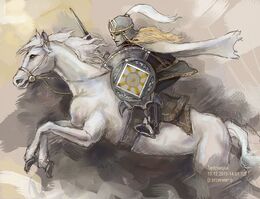The War of Wrath, or the Great Battle, was the war of Elves, Men, Dwarves and Valar against Morgoth at the end of the First Age, which marked the end of his rule in Middle-earth. It was the largest battle of the first age and possibly the largest battle ever to have taken place in Middle-earth, and decided the fate of the Silmarils. The war was so violent that it literally changed the face of middle-earth beyond recognition. It resulted in the expulsion of Morgoth from Arda and the destruction of most of northern Middle-Earth.
History
Background
By the early sixth century of the First Age, Morgoth had become mighty and uncontested in Middle-earth, not least because of the strife among the Ñoldor. The power of the Elves, Men, and Dwarves to resist him had been utterly destroyed, and along with all the great kingdoms of the Elves. Morgoth was now master of nearly all of Beleriand, save for the havens in Arvernien, which he gave little heed to. In this time of need, the mariner Eärendil, by the guidance of a Silmaril which he wore on his forehead, searched and came to Valinor on behalf of Elves and Men. There, he begged the Valar to pardon and aid the enthralled peoples of Middle-earth.
The Battle

Finarfin leads the Host of Valinor
The Valar were moved by Eärendil's plea, and along with the Vanyar and the remaining Ñoldor in Aman, came to Middle-earth in a mighty host. Of the Teleri of Alqualondë, they granted the use of their ships to the powers of Aman, but none would aid the Ñoldor in Middle-earth, remembering the Kinslaying of their people long ago and were still bitter about it. The great force of Aman marched across Beleriand, and met the terrible forces of Morgoth in the plains of Anfauglith.
The host of the Valar utterly destroyed the Orc armies of Morgoth, as well as most of the Balrogs, with minimal casualties (though in Annals and the Tale of the Years, the passage of the river Sirion are taken by the West only after 40 years of bitter fighting). While the Three Houses of Men fought alongside the Valar, many other Men from the East fought for the forces of Morgoth and were either destroyed or forced to flee back to the far eastern parts of Middle-earth. Facing final defeat, Morgoth, in a last desperate effort, released his ultimate weapon, the winged Dragons, which had never been seen before. Their terrible onslaught was accompanied by lightning storms and tempests of fire, and they drove the Valar back and nearly destroyed the entire force.
Just as it seemed the battle was lost, Eärendil came with his sky-ship Vingilot, along with the Eagles of Manwë led by Thorondor. In the skies above Angband, they contested with the dragons, slaying most of them despite suffering many losses. Eärendil himself slew their captain, the mighty Ancalagon the Black, who broke the towers of Thangorodrim in his fall. (A prophecy given in Athrabeth Finrod ah Andreth in Morgoth's Ring gives the slaying of Ancalagon to Túrin instead). It is not stated how exactly Eärendil managed to slay Ancalagon. This is something of a curiosity considering that Ancalagon's size was great enough to break the three mountains of Thangorodrim when he fell upon them, each of which were stated to be 5 miles across and 35,000 feet high.
Aftermath
Morgoth was finally captured in the deepest dungeon of Angband and bound again with his old chain Angainor; by the Vala Aulë and the two Silmarils still in his possession were taken by the Maia Eönwë, the herald of Manwë and guarded (whence they were later stolen by Maedhros and Maglor and cast into the sea and lost in the Earth) and Morgoth's crown was beaten into a collar for him. He was taken to Aman and tried for his crimes. In the end, the Valar unhoused Morgoth by beheading him and "thrust him through the Door of Night", beyond the Walls of the World, into the Timeless Void, the doors of which are forever guarded by Ëarendil. There he shall remain, a formless spirit, until the Final Battle and the Day of Doom (also known as the Dagor Dagorath).
The wreckage of the war was immense; most of the land west of the Blue Mountains was destroyed and soon after sank beneath the waves. While victory had been achieved, the casualties the Host of Valinor had suffered were catastrophic, most of the Edain, Elves and Dwarves had been slain by Morgoth's Dragons, along with many Maiar and Eagles, also slain by the dragons. Additionally, while the hosts of Morgoth were utterly defeated, the creatures that composed them were not eradicated, and many (particularly Orcs) remained to trouble the world under the power of Sauron while creatures like Balrogs fled and hid deep in the Earth. Durins Bane stands as an Example. The remaining elves were bidden by Ëonwë to return with him to the lands of Aman. Most of the Elves went into the West, while others still refused the summons and rather journeyed eastward where they would become lords of the remaining Eldar or those elves who still dwelt in the east. Gil-galad, Galadriel, Celeborn, and Elrond were chief among these.
For those men of the Edain who fought for the host of the Valar, the land of Númenor (in the full Quenya form Nùmenórë) was given to them. This land was neither of Aman nor of Middle-earth, but was indeed closer to Aman.[1][2]
Translations around the World
| Foreign Language | Translated name |
|---|---|
| Chinese (Hong Kong) | 憤怒之戰 |
References
- ↑ The Silmarillion, Quenta Silmarillion, Chapter XXIV: "Of the Voyage of Eärendil and the War of Wrath"
- ↑ The Atlas of Middle-earth, The First Age, The Elder Days, "The Battles of Beleriand"
